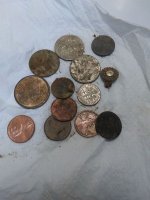Springfield
Silver Member
... Exactly how many mines they <Franciscans> were operating cannot now be established due to the loss of that archive in 1680, but it cannot have been a small number for the shipments of silver especially, coming out of New Mexico in the twenty years previous to 1680 were huge ...
The Franciscans' earliest New World forays are indeed intriguing and secretive, particularly Marcos de Niza's history before and after his famous travels ca 1538-40. That said, I need to take exception to your claim above - or ask for some verification.
It is true that there was some mining around Santa Fe during the 17th Century, but the Cerrillos mines yielded mostly copper minerals and the Ortiz mines some decent gold. Both sites show limited early activities. There was some silver mining near Soccorro during these times - probably those mentioned by Onate in an earlier letter back home - a modest recovery of lead/silver ore, but certainly not 'huge silver shipments' by any standards. New Mexico's abundant silver deposits were not in areas with an early Franciscan presence.
While Spanish mining had a place on the list of grievances that led to the 1680 Pueblo Revolt, it was a footnote compared to the natives' forced acceptance of the Franciscan religion and their general subjugation at the hands of the Conquistadors, via the Brothers.




